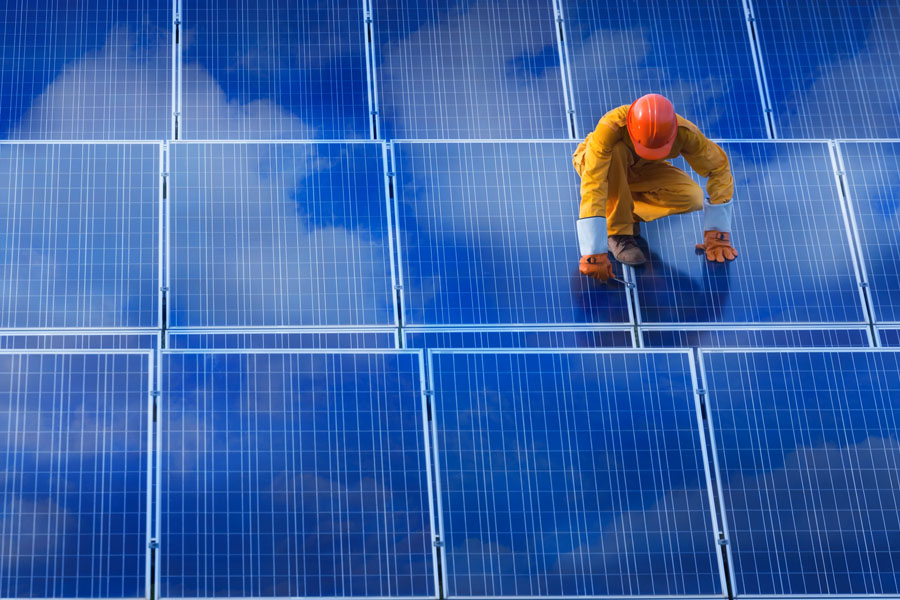A brief history of solar power
At a time when industrial activity, particularly the global construction industry, is exacerbating climate change, the sun is an invaluable resource.
Clean, efficient and limitless, the use of solar power is increasing across the world, from large-scale solar farm construction that spans thousands of acres to the growing number of residential buildings with solar panels on the roof.
Businesses, too, are considering solar panels to help provide energy for their operations and reduce their reliance on carbon-emitting fossil fuels.
While renewable energy is gaining in popularity, how much are we actually generating? Overall, renewable energy accounts for around 29% of total global electricity generated. In 2020, around 11% of that global renewable energy was generated by solar power, compared with 21% created by wind and more than 57% by hydro.
Given that the sun is always shining somewhere—173,000 terawatts of energy from the sun strikes the Earth at any point in time, 10,000 times more than is needed—there is clearly the potential for businesses and households to ramp up usage of its abundant power.
How does solar power work?
People have been converting energy from the sun into electricity and heat for thousands of years. The Romans used solar power to help heat their famous bath houses via thermal energy, and before them many cultures used shiny surfaces to reflect the sun’s rays to ignite fires.
More advanced harnessing of the sun’s potential as an energy source had to wait until the early 1950s, when a group of technologists working for Bell Labs in the US developed a silicon photovoltaic (PV) cell capable of absorbing and converting enough of the sun’s energy into power to run everyday electrical equipment.
According to the National Grid, solar panels are usually made from silicon installed in a metal panel frame with a glass casing: “When photons, or particles of light, hit the thin layer of silicon on the top of a solar panel, they knock electrons off the silicon atoms.”
“This PV charge creates an electric current, specifically direct current, or DC, which is captured by the wiring in solar panels. This DC electricity is then converted to alternating current, which powers things like household plug sockets.”
The rising demand for solar power
Domestic use
Solar panel construction has been a small but growing part of the UK building sector for some time, not least in new homes and those households looking to generate their own electricity via a retrofit programme. In the UK, around 970,000 homes have solar panels installed, yet that is just 3.3% of the country’s 29 million homes, according to the Committee for Climate Change.
Nonetheless, the potential is considerable. After the initial installation costs, which can run into thousands of pounds, buildings with solar panels will provide a reasonable return on investment. Annual savings can average about a few hundred pounds, and over the long term homeowners can save several thousand, depending on the location of a property and other factors, such as the pitch of its roof.
Corporate use
There is also potential for solar power to transform the way businesses generate power.
In the US, a number of retail chains, including Walmart and Costco, together with tech giant Apple, are already employing solar power technology to generate electricity across their estates.
Closer to home, examples include Nottingham-based builders’ merchant John A Stephens, which installed a new solar PV and smart grid system to extend what was already the largest such system in the UK.
As well as meeting the company’s own energy needs, the system’s supplier, EvoEnergy, estimates the merchant will sell around 73% of the electricity it generates back to the grid, and save 1.2 million kilogrammes of CO2 over the course of the system’s 25-year life.
It helps that these large shed-like properties have abundant roof space on which to install solar panels.
Environmental benefits of solar energy in construction
Solar energy could also play a part in changing how the built environment works, both in the way a building is powered once it is completed and how it is built.
Embodied carbon—that which is generated during a building’s construction—relating to buildings accounts for 11% of all carbon emissions, while 28% comes from a building’s day-to-day operations.
There are also the environmental implications of using fossil fuel-powered equipment vs. solar power for construction sites. Addressing this, a growing number of specialist suppliers now offer solar-powered construction equipment, as well as battery storage technology, claiming benefits which include zero emissions, silent operation, easy to set up, long-term cost savings and scalable.
Construction holds the key to a solar-powered future
It is fair to suggest that the construction sector has been somewhat slow to embrace new technologies, and the rollout of solar powered construction equipment is certainly in its infancy.
Construction firms, perhaps hard-pressed and facing a squeeze on their profit margins, might balk at the investment required to create a solar powered energy plan.
But with businesses waking up to the financial as well as environmental benefits of solar power, as many householders already have, it is inevitable that more firms will look to adopt PV technologies where they can.
Mobile PV systems, initially developed as hybrid units with diesel backup, are already on the market, and technological advances will surely see these become smaller, more powerful, lighter and easier to transport from site to site.
Many have recognised the long-term benefits of using the big golden disc in the sky to generate the power we need. The construction industry can surely benefit from doing likewise.











